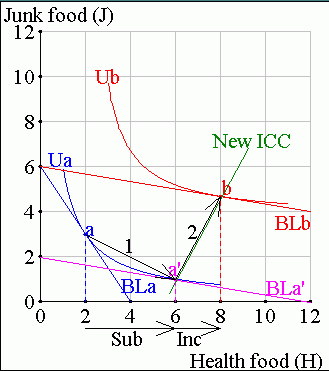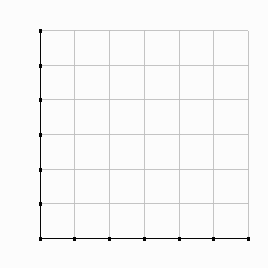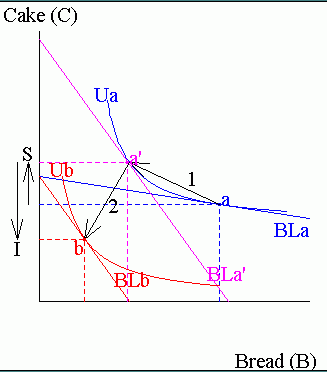? Which indifference curve reflects
the original utility?
? Which budget line reflects the new
price?
(1) a --> a' = the substitution effect
(sub)
(2) a' --> b = the income effect (inc)

|
Friday, February 15, 2013 |
II. Consumer demand
B. Extensions and
applications of consumer theory
2. Substitution and income effects
In practice,
a price change generally affects you 2 ways:
(1) It changes your optimal MRS --> the substitution effect
(2) It changes your utility --> the income effect
Both changes affect consumption choices
Substitution and income effects separate out these impacts on consumption.
Learning objectives: Illustrate and explain the substitution effect and income effect of a price change.
a. Basic analysis
The geometry: (sub and inc effects (Java))
|
To see the 2 effects of a price change: slide the new BL back to where it is tangent to the
old IC. ? Which indifference curve reflects
the original utility?
(1) a --> a' = the substitution effect
(sub)
|
 |
The reasoning:
A price change affects quantity
demanded because of....
(1) The substitution effect:
the consumption adjustment you make because the new price changes the relative
attractiveness of the goods you buy.
a-->a' shows this: move to the new relative price on your original indifference curve
Ex: Health food and junk food: A lower relative price (of health food=goodX)
makes you tend to substitute health food for junk food (goodY).
Makes the new BL flatter than before, so you move to a flatter part of
any indifference curve you might be on
(2) The income effect:
the consumption adjustment you make because the new price changes your attainable level of
well-being.
a'-->b shows this: you move to your new indifference curve at
the new price
For example, when price falls, the increase
in your utility prompts you to change your consumption of health food.
? Is health food a normal or inferior
good?
? How can you tell?
? True or false: When
the price of a good falls
(1) The substitution effect always tends to increase
consumption of it.
(2) The income effect always tends to increase consumption of
it.
Summary of possible substitution and income effects:
Px/Py falls: effect on consumption of X (+/-/0/?):
| Normal good | Inferior good | |
| Substitution effect: | ||
| Income effect: | ||
| Combined effects: |
Key results: The substitution effect always makes us
consume more of a good when it gets cheaper and less of it when it gets more expensive.
It's the pure version of the 'law of demand'.
The income effect of a lower price makes consumption rise for a normal
good but fall for an inferior good.
Substitution effect: large when good substitutes are
available.
string beans and lima beans
Income effect: large when the budget share of the
product is high.
housing, staple foods for the poor
Good counterexample: salt
No good substitute and a small budget share. Both effects are small, so
demand for salt is very inelastic.
b. Applications
Failure to separate substitution and income effects can lead to some counterintuitive results.
(1) Giffen goods--How substitution and income effects influence
consumer demand:
Giffen Behavior and
Subsistence Consumption (2008)
|
Example: rice in Hunan. C1: Households are poor enough that they face subsistence nutrition concerns. C2: Households consume a very simple diet, including a basic (staple) and a fancy good. C3: The basic good is the cheapest source of calories available, comprises a large part of the diet/budget, and has no ready substitute. C4: Households cannot be so impoverished that they consume only the staple good. Rice = 64%
of calorie intake |
 |
|
So, how did this happen? See
worksheet (available online: Substitution and income effects: alternative possibilities) The substitution effect always makes quantity demanded rise when price falls and vice versa. But the market demand curve includes both substitution and income effects. For a normal good, the substitution and income effects reinforce each other => D will slope down ? True or false: All Giffen goods are inferior goods, but not all inferior goods are Giffen goods. Recap: Necessary conditions for a Giffen good: |
|
(2) Counterintuitive cross-price elasticities
Explore as a homework problem.
Recall, cross-price elasticities tell us whether
goods are substitutes or complements.
We know in fact that the distinction shows up in the shape of
indifference curves, but in practice, when the price of one good changes, we don't stay on
a single indifference curve.
This can cause income and substitution effect problems.
| Ex: Marie
Antoinette (+Pbread: "Let them eat
cake.") (example (Java)) ? Did Marie Antoinette consider bread and cake to be substitutes or complements? ?How did you decide? Let: Let the price of bread rise, and consider first the
substitution effect. But as utility falls due to the higher price of bread, consumers will move back down their income consumption curve to reach BLb, and the income effect will make cake consumption fall if cake is a normal good. |

|
|
|
Overall:
1 = substitution effect--raises cake consumption.
2 = income effect, lowers cake consumption.
Combined: cake consumption can fall as the price of bread rises.